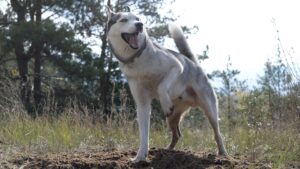Heavy rare earths are the name of the game at Asra’s Yttria deposit

Drilling has returned thick zones of REEs with high HREO ratios at Asra’s Yttria deposit. Pic: via Getty Images
As its name might suggest, the Yttria deposit within Asra Minerals’ Mt Stirling project near Leonora, Western Australia, is shaping up to be a significant rare earths and scandium play.
This has been clearly highlighted by the latest results from its recent 100-hole reverse circulation drill program which returned thick rare earth zones with grades of up to 2,715 parts per million (ppm) total rare earth oxides (TREO) and a preponderance of valuable heavy rare earths (HREO) such as dysprosium and terbium (DyTb).
DyTb oxide has a massive impact on the value of any basket of REEs given that it is worth about US$1,000/kg.
Exceptional HREO intervals making up to 86% of the total REE content define Yttria as a potential important source of critical, high value HREOs in the Tier 1 mining district just 240km north of Kalgoorlie.
Adding further interest for Asra Minerals (ASX:ASR) the shallow REE zones of up to 25m thick are complemented by scandium-rich zones up to 46m thick and with grades of up to 187ppm.
Managing director Rob Longley said the latest drill results that continue to highlight heavy rare earth enrichment and consistent near-surface, elevated concentrations of terbium and dysprosium, have strengthened the company’s understanding in the uniqueness and potential significance of Yttria.
“Furthermore, we are noticing that the zones extend under previous shallow drilling (for gold geochemistry) that did not reach the REE horizon,” he added.
“That leaves great upside even at Yttria, while we also expand the REE footprint with ongoing soil geochemistry across our adjacent tenements.
“It’s important to realise that while most REE projects in Australia have been known for many years, Yttria was only recently discovered, so we are still learning, and are very excited with the upside potential and value being revealed, as the deposit knowledge and scale grows.”
REE drill intercepts
The new results of 25m at 722ppm TREO (with 25.4% magnet REEs) from just 1m in hole MSC0378 and 9m at 937ppm TREO (76% HREO) from 10m including 4m at 1,436ppm TREO (86% HREO) in hole MSC0336, contribute to Yttria’s emergence as an exceptional, near-surface regolith-hosted Ionic REE deposit.
This is enhanced by having an average of 57% HREOs and high levels of scandium in the same regolith.
Drilling to date has defined a 2km wide zone of near-surface, clay-hosted REEs up to 25m that remains open to the east and west as well as along strike.
Re-assaying of historical holes which were only tested for gold and arsenic has also returned a large number of high REE grades which indicate that REE mineralisation is potentially more extensive than initially considered.
Scandium bonus
The widespread presence of scandium is a bonus on top of this with Longley noting that Rio Tinto’s recent purchase of the Platina’s Deposit in New South Wales had underscored the metal’s future importance for hydrogen fuel cell construction and ultra-light and strong alloys.
“At Yttria, the rare earth zones in the regolith clays are completely enveloped by a 70-100ppm scandium oxide profile that will be a valuable bonus when we get to an initial pit optimisation stage,” he noted.
Road ahead
Asra still has assays from a further 74 drillholes outstanding and from 21 re-sampled RC holes.
Its exploration field teams are currently undertaking step-out soil geochemistry surveys using handheld XRF spectrometers that are calibrated for REE and collecting additional samples from different defined geological domains defined by the new drill assay results, to add to the metallurgical bulk sample.
While drilling has tested 3.5km of the REE footprint, the company plans to test the strike continuity of REE and scandium across the entire +20km strike potential at Mt Stirling within its current tenement holding.
This article was developed in collaboration with Asra Minerals, a Stockhead advertiser at the time of publishing.
This article does not constitute financial product advice. You should consider obtaining independent advice before making any financial decisions.
Related Topics

UNLOCK INSIGHTS
Discover the untold stories of emerging ASX stocks.
Daily news and expert analysis, it's free to subscribe.
By proceeding, you confirm you understand that we handle personal information in accordance with our Privacy Policy.








